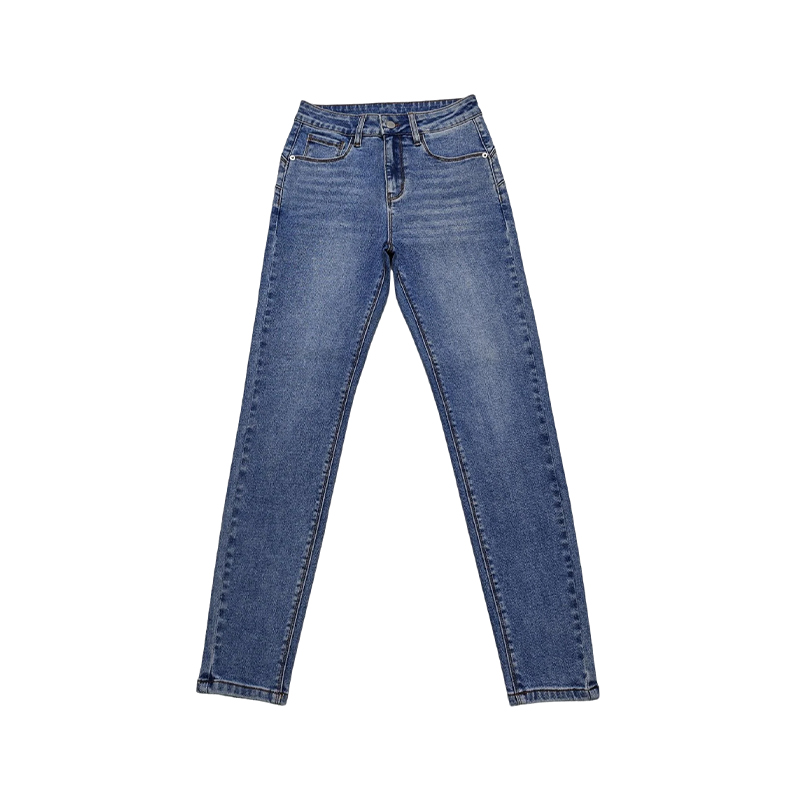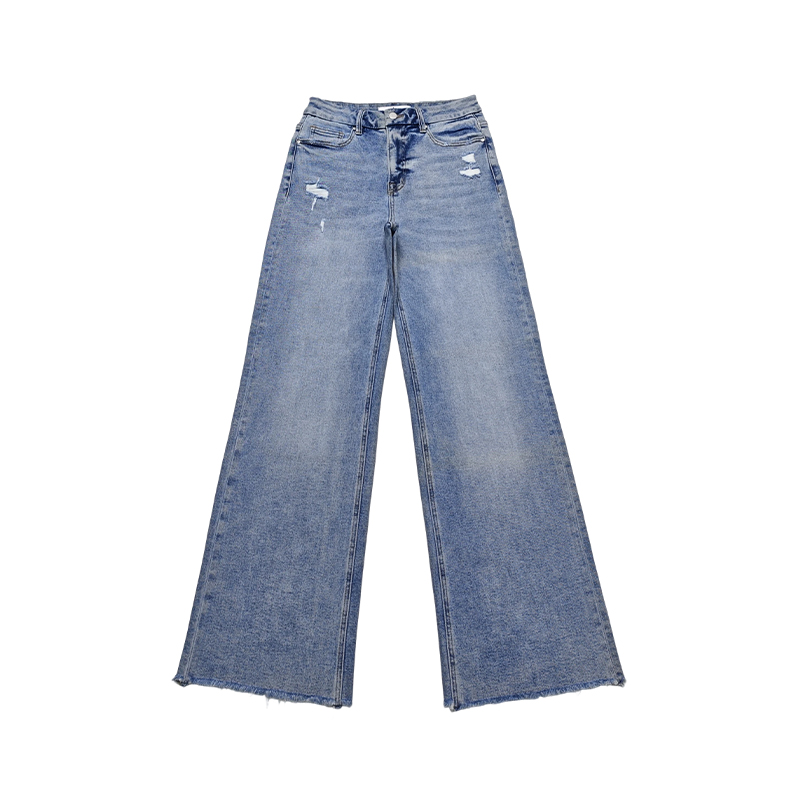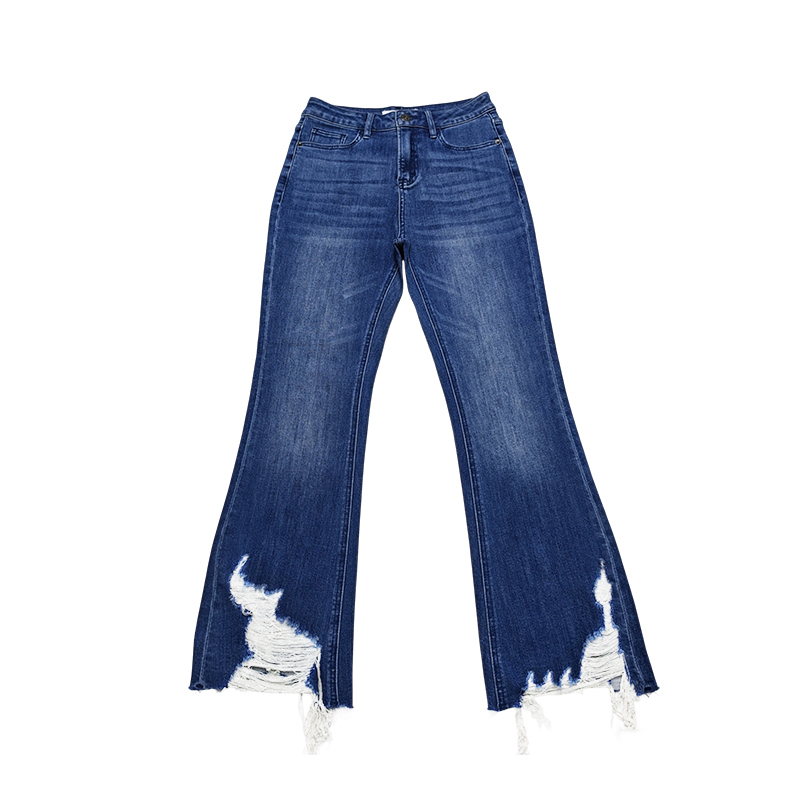How to avoid the crotch problem of high-waisted long jeans with three-dimensional crotch cutting?
Release Time : 2025-10-11
The key to solving the crotch-binding problem in high-waisted, long-length jeans is the 3D tailoring of the crotch. Its design requires precise ergonomics, with details like optimizing the crotch curve, adjusting the front and back waves, and enhancing the fabric's elasticity. This ensures a comfortable fit for prolonged sitting and unrestricted movement. Traditional, flat-cut jeans often suffer from a mismatch between the crotch curve and the human body's physiology, leading to excessive tension in the crotch when walking or squatting. 3D tailoring, however, uses 3D modeling technology to divide the crotch area into multiple curved modules, simulating the natural morphology of the human body during standing and movement. This creates a natural allowance at key stress points, preventing crotch-binding caused by concentrated tension.
The scientifically determined length of the front wave is a key parameter in 3D tailoring. A front wave that is too short can cause a noticeable drop in the crotch, while one that is too long can compress the lower abdomen. In draping, the length of the front wave needs to be dynamically adjusted based on waistband height and hip circumference. For example, the front wave of high-waisted jeans is typically 1-2 cm longer than that of mid-waisted jeans to accommodate the raised waistline. At the same time, the curved cut allows the front crotch fabric to naturally follow the curve from pubic bone to perineum, reducing fabric bulk. The back wave design should complement the front wave, with a more gradual curve than the front crotch to distribute pressure during hip movement and prevent the back waist fabric from sliding down due to excessive stretching.
The synergy between fabric elasticity and tailoring significantly affects crotch sticking. High-waisted jeans made of pure cotton, while breathable, lack stretch. Dimensional tailoring requires increased crotch allowance to compensate for this lack of elasticity. Stretch denim with spandex or lycra components, on the other hand, allows for a more fitted cut and reduces allowance. Professional cycling jeans often feature 3D cuts made of high-stretch fabrics, laser-cut to achieve a zero-waist fit while utilizing the fabric's elasticity to distribute pressure across the crotch. This design principle also applies to high-waisted jeans.
Detailed crotch construction is crucial for preventing crotch pinching. For example, the diamond-shaped crotch patching technique creates 2-3 cm of dimensional space by inlaying triangular stretch fabric at the crotch base, allowing the fabric to fold naturally during movement without constricting. A Y-shaped cut utilizes diagonal panels extending from the crotch base toward the inner thighs to distribute friction at the base of the thighs. Furthermore, a design in which the back crotch is 1.5 cm longer than the front crotch effectively balances the force differential between the hips and thighs, preventing crotch displacement caused by hip slumping.
The application of ergonomics to 3D tailoring must consider the characteristics of different body types. For example, for those with bow legs or muscular legs, the crotch stress point is more concentrated on the inner thighs. Therefore, draping should distribute this pressure by widening the side seam allowances and adjusting the crotch curvature. For those with a high waist-to-hip ratio, optimizing the waist dart design ensures a more balanced fit between the waist and hips to prevent uneven crotch stress. During custom tailoring, the tailor will use a draping mannequin to simulate the individual's body shape and precisely adjust the crotch parameters.
Wearing habits are equally important as the adaptability of draping. Pulling the front crotch fabric up 2 cm before sitting can temporarily relieve crotch pressure. Wearing a long top that covers the crotch area can reduce friction between the fabric and the chair seat. For daily care, softening the crotch seams with a steam iron before first wear can reduce tightness caused by hardening of the fabric. Soaking the denim in a denim softener monthly can maintain elasticity and prolong the effects of draping.
The three-dimensional tailoring of the crotch in high-waisted, long jeans is the product of a comprehensive system involving ergonomics, fabric science, and cutting techniques. From the curved front wave to the elastic fabric selection, from the diamond-patterned patching to the personalized customization, every detail is centered around the core goal of "reducing concentrated tension and distributing pressure during movement." Only when the tailoring lines perfectly align with the body's curves, and the fabric's elasticity dynamically matches the range of motion, can high-waisted jeans truly achieve both comfort and aesthetics.







